Squamous carcinoma cells influence monocyte phenotype and suppress lipopolysaccharide-induced TNF-alpha in monocytes
- PMID: 20084448
- PMCID: PMC2888725
- DOI: 10.1007/s10753-009-9175-6
Squamous carcinoma cells influence monocyte phenotype and suppress lipopolysaccharide-induced TNF-alpha in monocytes
Abstract
Bacteria and chronic inflammation are present in squamous cell carcinoma of the head and neck (HNSCC), but their roles in the pathogenesis of HNSCC are unclear. Our studies described here revealed that human monocytes co-cultured short term with HNSCC cells were more likely to express CD16, and CD16(+) small mononuclear cells were common in HNSCC specimens. In addition, we identified monocytes as the primary source of LPS-induced IL-6 and TNF-alpha in the monocyte-HNSCC co-cultures. Remarkably, relative to LPS-stimulated monocytes cultured alone, HNSCC cells profoundly suppressed LPS-induced TNF-alpha in monocytes, without compromising IL-6 production. High levels of cytoprotective factors like IL-6 and low levels of TNF-alpha are important for the tumor microenvironment that enables tumor cell survival, affects monocyte differentiation and may contribute to tumor colonization by bacteria. This study provides novel observations that HNSCC cells affect monocyte phenotype and function, which are relevant to the regulation of the HNSCC microenvironment.
Figures
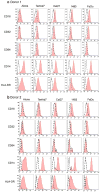


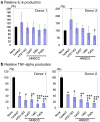
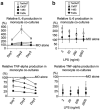
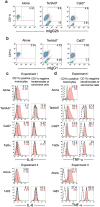

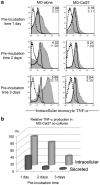
Similar articles
-
Human autologous monocytes and monocyte-derived macrophages in co-culture with carcinoma F-spheroids secrete IL-6 by a non-CD14-dependent pathway.Scand J Immunol. 2001 Feb;53(2):162-70. doi: 10.1046/j.1365-3083.2001.00853.x. Scand J Immunol. 2001. PMID: 11169220
-
Monocytes secrete interleukin-6 when co-cultured in vitro with benign or malignant autologous fragment spheroids from squamous cell carcinoma patients.Scand J Immunol. 2000 Mar;51(3):271-8. doi: 10.1046/j.1365-3083.2000.00680.x. Scand J Immunol. 2000. PMID: 10736096
-
Lipopolysaccharide-squamous cell carcinoma-monocyte interactions induce cancer-supporting factors leading to rapid STAT3 activation.Head Neck Pathol. 2008 Mar;2(1):1-12. doi: 10.1007/s12105-007-0038-x. Head Neck Pathol. 2008. PMID: 19603082 Free PMC article.
-
Monocyte and monocyte-derived macrophage secretion of MCP-1 in co-culture with autologous malignant and benign control fragment spheroids.Cancer Immunol Immunother. 2001 Aug;50(6):300-6. doi: 10.1007/s002620100204. Cancer Immunol Immunother. 2001. PMID: 11570583 Free PMC article.
-
In Vitro-Stimulated IL-6 Monocyte Secretion and In Vivo Peripheral Blood T Lymphocyte Activation Uniquely Predicted 15-Year Survival in Patients with Head and Neck Squamous Cell Carcinoma.PLoS One. 2015 Jun 16;10(6):e0129724. doi: 10.1371/journal.pone.0129724. eCollection 2015. PLoS One. 2015. PMID: 26079381 Free PMC article.
Cited by
-
Role of dendritic cell-mediated immune response in oral homeostasis: A new mechanism of osteonecrosis of the jaw.FASEB J. 2020 Feb;34(2):2595-2608. doi: 10.1096/fj.201901819RR. Epub 2020 Jan 9. FASEB J. 2020. PMID: 31919918 Free PMC article.
-
Dendritic Cells (DC) Facilitate Detachment of Squamous Carcinoma Cells (SCC), While SCC Promote an Immature CD16(+) DC Phenotype and Control DC Migration.Cancer Microenviron. 2013 Apr;6(1):41-55. doi: 10.1007/s12307-011-0077-4. Epub 2011 Aug 2. Cancer Microenviron. 2013. PMID: 21809059 Free PMC article.
-
Distinct patterns of intratumoral immune cell infiltrates in patients with HPV-associated compared to non-virally induced head and neck squamous cell carcinoma.Oncoimmunology. 2015 Jan 30;4(1):e965570. doi: 10.4161/21624011.2014.965570. eCollection 2015 Jan. Oncoimmunology. 2015. PMID: 25949860 Free PMC article.
-
Salivary and Serum Interleukin-6 Levels in Oral Premalignant Disorders and Squamous Cell Carcinoma: Diagnostic Value and Clinicopathologic Correlations.Asian Pac J Cancer Prev. 2016 Nov 1;17(11):4899-4906. doi: 10.22034/APJCP.2016.17.11.4899. Asian Pac J Cancer Prev. 2016. PMID: 28032493 Free PMC article.
-
The Potential of CD16 on Plasma-Derived Exosomes as a Liquid Biomarker in Head and Neck Cancer.Int J Mol Sci. 2020 May 26;21(11):3739. doi: 10.3390/ijms21113739. Int J Mol Sci. 2020. PMID: 32466374 Free PMC article.
References
-
- Gallo O, Gori AM, Attanasio M, Martini F, Giusti B, Brunelli T, et al. Interleukin-6 and acute-phase proteins in head and neck cancer. European Archives of Oto-Rhino-Laryngology. 1995;252:159–162. - PubMed
-
- Druzgal CH, Chen Z, Yeh NT, Thomas GR, Ondrey FG, Duffey DC, et al. A pilot study of longitudinal serum cytokine and angiogenesis factor levels as markers of therapeutic response and survival in patients with head and neck squamous cell carcinoma. Head and Neck. 2005;27:771–784. - PubMed
-
- Chen Z, Malhotra PS, Thomas GR, Ondrey FG, Duffey DC, Smith CW, et al. Expression of proinflammatory and proangiogenic cytokines in patients with head and neck cancer. Clinical Cancer Research. 1999;5:1369–1379. - PubMed
-
- Sparano A, Lathers DM, Achille N, Petruzzelli GJ, Young MR. Modulation of Th1 and Th2 cytokine profiles and their association with advanced head and neck squamous cell carcinoma. Otolaryngology - Head and Neck Surgery. 2004;131:573–576. - PubMed
Publication types
MeSH terms
Substances
Grants and funding
LinkOut - more resources
Full Text Sources
Medical

